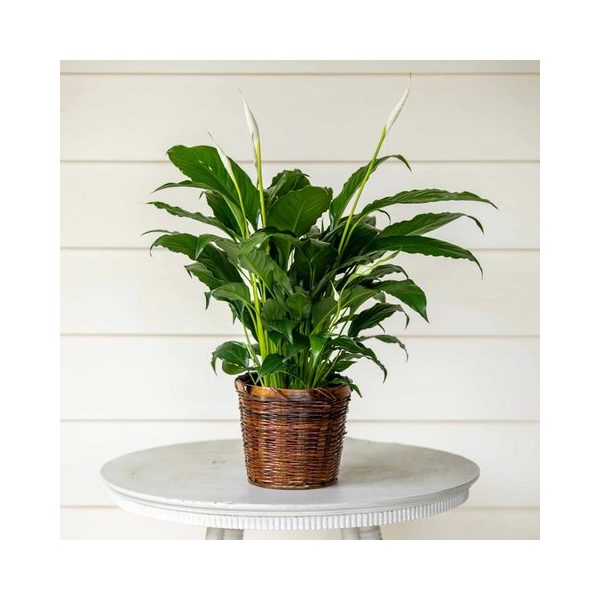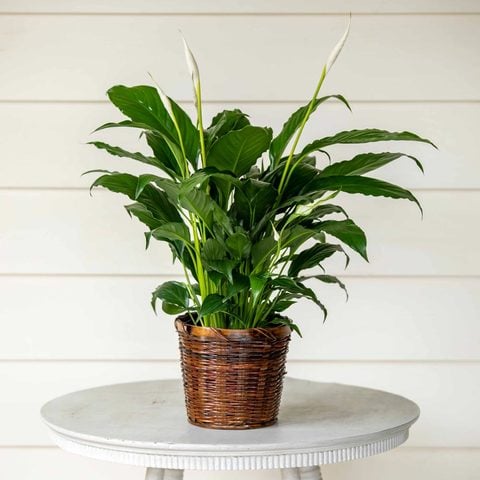Peace Lily Care

Spathiphyllum are among the most commonly grown houseplants because they are easy to care for while rewarding growers with continual blooms. These tropical evergreens are beloved for their elegant white spathe flowers that emerge from lush, green foliage—the optimal complement to any home or office décor. The common name, “Peace Lily,” is derived from the flowers, which are said to resemble white flags, the universal symbol for peaceful intentions.
While there are dozens of Peace Lily varieties, White Flower Farm offers three distinct types:
- Sensation – the largest variety, which can reach 6’ in height and width
- Domino – the variegated Peace Lily
- Flower Bunch – our signature cultivar, which produces abundant flowers
Peace Lilies are easy-care plants that will grow in just about any setting, though they develop superior foliage and abundant blooms in the right growing conditions.
Technically, Peace Lily do not produce true flowers; rather they are long-lasting spathe (bracts) with a center spadix covered with tiny flowers. The spadix can be removed to prevent pollen on the leaves, if found to be messy.
How to Care for a Peace Lily
Light: The Peace Lily thrives in bright, indirect light. While it has earned the nickname “closet plant” for its ability to survive in low levels of light, this name is not quite appropriate, as insufficient light will hinder growth and stunt flower production. When grown indoors, placing your Peace Lily in an east-facing window allows it to receive ample morning sun to fuel proper growth.
Watering: Peace Lilies thrive in continually moist, but not soggy soil. Check the soil every few days, adding water whenever the top 1” feels dry. Water your Peace Lily thoroughly, but be careful not to let the plant sit in water, as this is the most common cause of problems.
These plants are ideal for forgetful owners because the leaves will droop when the plant gets too dry—a sure sign it needs water. Because the Peace Lily is fairly forgiving, some growers prefer to wait until their plant begins to droop before watering it. While this will not harm the plant, be careful not to let it dry out for too long, as this can cause the leaves to yellow and/or brown and inhibit flowering.
Humidity: Peace Lily are particularly partial to humidity and will perform better with it in a home environment. A humidifier or plant humidity tray will work for this purpose.
Fertilizer: For best results, fertilize your Peace Lily monthly throughout spring and summer. Each month, alternate between a balanced houseplant fertilizer to support overall growth and a blossom-boosting fertilizer to encourage flowering. As with most houseplants, do not fertilize Peace Lilies in fall and winter when the plant is dormant.
Soil: Peace Lilies thrive in rich, loose soil. They are native to the forest floor, where they flourish in the naturally rich compost. A potting mix such as Organic Mechanics Premium Blend Potting Soil, which is rich in organic material while helping to regulate moisture, will support optimal growth.
Peace Lilies can also be grown hydroponically, though they will not live as long as they would in soil. To grow a Peace Lily in water, place the root ball directly in distilled water, taking care to keep the base of the plant dry to avoid rot. Change the water every few weeks, keeping the roots wet at all times, and apply a few drops of liquid fertilizer during spring and summer growth periods.
Pruning: Peace Lilies require minimal pruning for healthy growth. As the plant matures, older leaves will turn yellow and shrivel up. Use clean shears to deadhead spent flowers and remove yellow leaves at their base. Peace Lilies are toxic, so always wear gloves when handling your plant and wash hands thoroughly afterward.
Repotting: If your Peace Lily is becoming rootbound, consider repotting it to a container at least 2” larger in diameter. If you prefer, you can also split your plant while repotting by using clean shears to sever the root ball in half. This hardy plant can survive some rough treatment during repotting and splitting—as long as the rhizome is intact, new growth will continue to emerge.
Pests/Diseases: As with most plants, incorrect growing conditions and common household pests can harm your Peace Lily. The most common ones:
- Scale/mealybugs appear as tiny bumps, soot-like mold, or white fuzz on the stalks and stems of plants. Wipe down affected areas with a wet cloth or apply a natural insecticide, like neem oil. Repeat removal may be required to keep the pests at bay. If the infestation goes unchecked, it can damage or kill plants, so it is best to treat any pests immediately.
- Root rot can occur if the Peace Lily is overwatered. Ensure your plant has adequate drainage and water it only when the top of the soil feels dry.
Troubleshooting: Peace Lily Common Problems
- Drooping is usually a sign that your Peace Lily needs water immediately. In some instances, an overwatered plant may also droop, though it will be much less pronounced. If your Peace Lily is drooping, check the soil by poking a finger into the top few inches—if it feels dry, water your plant thoroughly.
- Brown Tips on a Peace Lily plant can indicate issues with moisture or fertilization. Too little water can cause leaf tips to turn brown, while soggy soil can also result in brown tips. If the atmosphere is extremely dry, consider using a humidifier or placing the plant on a large saucer filled with pebbles and water. Watering your Peace Lily using tap water with a high salt content can cause leaf tips to brown. Peace Lily are also sensitive to fluoride in tap water. Try switching to distilled or rain water if you suspect your water is causing problems. Excessive fertilizer can also cause leaf tips to brown—ensure you are following the instructions above for fertilizing your Peace Lily, and never give these houseplants fertilizer during fall and winter months when they are dormant. Peace Lilies are also easily damaged by excessive sunlight. Consider moving the plant to a darker location if you suspect the brown tips on leaves are the result of sunburn.
- Yellow Leaves can be completely normal as your Peace Lily sheds older leaves. But if multiple leaves suddenly turn yellow, this is typically a sign that the plant is not receiving the correct amount of water and/or light. Follow the instructions above for watering, keeping the plant continually moist but not soggy, and consider moving the Peace Lily to a darker location.
- Brown Leaves generally indicate that the Peace Lily is not receiving proper care. Review instructions for sunlight, soil, watering, and fertilizing to ensure you are providing proper care for your plant. If you are following all the instructions and your plant is still showing brown leaves, it may be time to repot it and refresh the soil.
- Flowers Turning Brown is a normal part of the Peace Lily growth cycle. After about 10 days, Peace Lily flowers will turn brown and die off, at which point you can deadhead them to maintain the appearance of your plant. If new blooms are suddenly turning brown, this can be a sign of a stressed plant—review the care instructions to ensure your plant is receiving appropriate levels of sunlight, water, and fertilizer.
Frequently Asked Questions
Are Peace Lilies toxic to cats?
Yes, Peace Lilies are toxic to cats, dogs, and humans. While they’re not considered poisonous like other Lily varieties, accidental ingestion can cause oral irritation, burning, drooling, and vomiting. Keep Peace Lilies away from curious pets and children, and always wear gloves when handling your plant.
Can Peace Lilies grow outside?
Peace Lilies are tropical plants which can be grown outdoors in USDA Hardiness Zones 10–12. Place your Peace Lily outdoors in a shady spot to protect it from direct sunlight, which can burn the leaves.
When do Peace Lilies bloom?
Mature Peace Lilies typically produce white blooms in the spring and fall. If your plant is not blooming, it may need more light. Try moving it to a brighter area where it receives at least three hours of indirect sunlight each day.
How long do Peace Lilies live?
Peace Lily plants generally live between 3 and 5 years with proper care.



